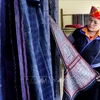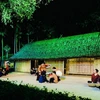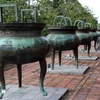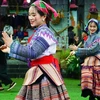 At 12 o'clock of the ceremony, the child is allowed to wear the costume of the Dao Tien ethnic group to start the Naming Ceremony (Photo: Vu Ha / VNA)
At 12 o'clock of the ceremony, the child is allowed to wear the costume of the Dao Tien ethnic group to start the Naming Ceremony (Photo: Vu Ha / VNA)
Hanoi (VNA) - It is customary for the Dao Tien male at 10 years old or older to undergo a second birth in a lifetime through the ceremony of Lap Tinh (also known as the naming ceremony) to become a true man.
For Dao Tien people, the naming ceremony is an important task and a milestone in the life of the Dao boys and this marks the transition from childhood to adulthood.
The ceremony reports to the gods and ancestors on the second naming for the son in the lineage. Upon death, descendants will worship the passing under the second name.
In particular, when worshiping the profession of proclamation to the ancestors, the Dao people will refrain from using their real names, instead, they just use the second name from the Naming Ceremony.
Naming Day is the happy day of family, and also the important day of the whole village. The compulsory ritual consists of chicken, wine, rice and 4 big pigs.
To prepare for the ceremony which lasts from morning to afternoon, the family had to get up from 2 am, preparing sticky rice cake. It requires around 100 hands wrapped stick rice in Dong leaves. Chicken and pork are then prepared as main dishes for guests and visitors.
The main ceremony is held at night and lasts until morning. The ceremony includes: traditional dress, belt, head scarf, cap, all made of brocade woven with a bell and two sets of paintings. The long picture set has 6 pieces, the short one consists of 2 pictures, so that when the ceremony is done, the shaman and the child will wear it on the head. There are 6 sticky rice cakes along with a bowl of water, two candles on the main altar; the smaller altar have two small tables, each with 6 bowls of wine, a bowl of water, three candles and 12 sticky rice cakes. Two prestigious shamans were invited to worship for two days and two nights.
At 12 o'clock on the first night of the ceremony, the son will have to eat one chicken with his father. The name was given at 1AM in the morning. The neighbors and villagers came to congratulate the child and wishing him a healthy, long-lived life with the name has been given. After that, the sound of drums, gongs, and flutes resounded to signal the beginning of the ceremony. At this time, the shaman and the child will have to dance continuously until morning.
People sing and dance and it is called cheo singing. The cheo singing is performed only in the Lap Tinh ceremony. It is a dance routine that invites ancestors to witness. On the second day, the family continued to prepare pork to worship.
At night, the shamans take turns to perform the ceremony, 6 people including 3 men and 3 women dancing together and singing different songs. At the end of the Naming Ceremony at 12 pm on the second day, the family offers the guests and shaman the offerings.
It can be said that the Lap Tien ceremony of the Dao Tien people still exists today has contributed to preserving many types of folk culture of the Dao ethnic group. If you want to attend the Lap Tien ceremony of the Dao Tien people, you should go to the Dao villages around November, December or in the spring./.



















